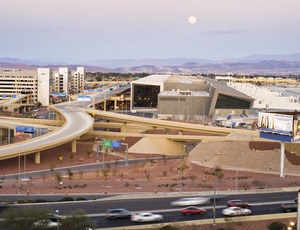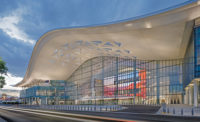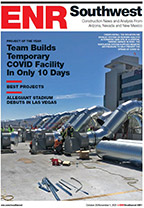
When McCarran International Airport's $2.4-billion third terminal complex opens on June 27, it will mark the beginning of long delays for new big projects in the region.
The three-level, 1.9-million-sq-ft building comes with a 5,954-space, 2.3-million-sq-ft, $121.7-million garage built by McCarthy Building Cos., an eight-mile elevated roadway system and a 900-ft-long automated connecting tram. It brings the four-runway, 2,800-acre McCarran to final build-out.
The five-year job employed 1,800 people working more than 9.5 million man-hours. "It's a bit of a letdown to see it done," says Sean Stewart, executive vice president, Associated General Contractors, Las Vegas chapter. "There aren't any billion-dollar projects on the horizon."
Bechtel Infrastructure Corp. was the program manager; Perini Building Co. was general contractor for the $1.2-billion terminal. Last year, McCarran was the world's 20th-busiest airport, with nearly 41.5 million passengers. Its international passengers are expected to quadruple to 30% from 7% in the next 15 years, says Director Randall H. Walker. The 14-gate terminal has seven international gates and a 60,000-sq-ft, 28-lane customs and border-protection area capable of processing 2,000 visitors an hour.
"The owner wanted to incorporate as much flexibility as possible into the building," says Bechtel's project manager, Don Wright. The parallelogram-shaped terminal, designed by PGAL, increases efficiency by 15% through extensive technology. There are self-baggage checks, self-boarding gates and automated aircraft docking with LED displays. The building uses 1.5-million linear ft of electrical wire and cable and can process 440,000 passengers a hour. It also has 16 in-line security scanners and eight miles of second-generation RFID baggage conveyors.
McCarran provided a nearby 53-acre property for construction storage, while a project labor agreement prevented any work stoppages. "We undertook a partnering approach to coordinate activity with the adjacent contracts," says Perini Vice President Michael Kerchner. "We held weekly open-door coordination sessions with other contractors and kept an open line of communication."



Post a comment to this article
Report Abusive Comment